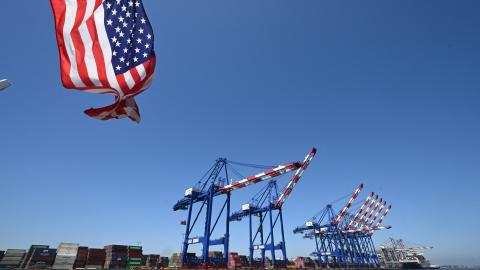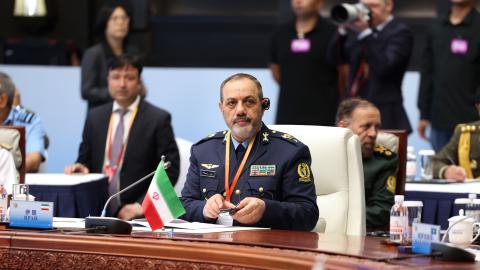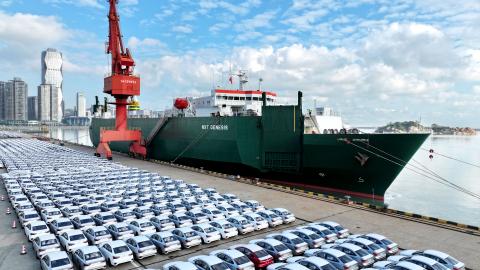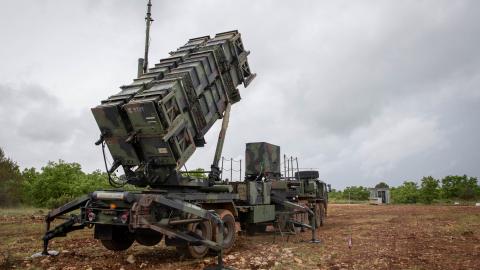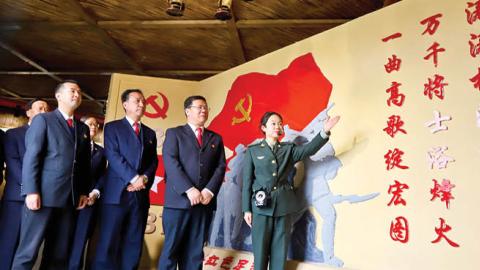The United States now finds itself in the midst of a “long, twilight struggle” with the People’s Republic of China (PRC) over the future of U.S.-PRC relations and of world order at-large. Some components of this struggle are conspicuous, part of daily news accounts about diplomatic, commercial, and military developments in Asia and beyond. However, less visible components—cultural, philosophical, and intellectual—bear directly on Sino-American relations and may prove more consequential over the long run. Meanwhile, technological advances and the PRC’s ongoing bid to perfect its police state at home while enmeshing other countries in a new China-dominated world system are expanding the scope and scale of the contest; it encompasses not just the Indo-Pacific and the Eurasian landmass, but cyberspace and outer space, and, fundamentally, the future of humane and republican self-government.
How should Americans understand the complexity of this situation? Is it nothing but two powerful states jockeying to improve their position within a shifting global “balance of power?” Is it primarily an ideological struggle between advanced democracies and an outmoded form of Leninist authoritarianism? Or is it something deeper—a “clash of civilizations?”
Some observers, drawing on America’s experience with the Soviet Union, describe emerging U.S.-PRC relations as a “new Cold War.” But one great risk in invoking the decades-long rivalry with the Soviet Union is the complacency that comes from the assumption that the twilight struggle of our own time will end as happily as the last one did. Even so, the comparison does have the merit of recognizing that the PRC is now the main challenge to U.S. national security and foreign interests. Yes, there are other foreign challenges, but success in any of those will not overcome failure in the principal one.
In all this, an essential first step is understanding that the long struggle with the PRC is not new; it is the continuation of one that began in 1921 with the founding of the Chinese Communist Party (CCP). Since the CCP seized control of China and created its People’s Republic in 1949, the contest has gone through several phases, including a most recent one in which the CCP chose “peaceful coexistence” with the United States as a tactical expedient. Now that the party under Xi Jinping has changed its tactics, U.S. policymakers need to understand the deeper sources of the CCP’s new orientation, i.e., its “operational code,” and how it is likely to direct its future behavior. It is especially necessary for the United States to understand that the CCP’s actions in the world at-large are animated by its primary struggle at home—that is, with China itself. The thing most characteristic of the CCP’s rule since 1949 has been its forceful imposition. The CCP has spent decades fighting opposition inside its claimed empire and yet opposition of all kinds continues to exist. What is the nature of this resistance to CCP rule? Why has it lasted so long? Why is it that the regime still constantly describes itself as embattled, as at war on many fronts?
This bedrock struggle between the CCP and China has existed since the party created the PRC as its tool to secure its political survival and power over China and other large parts of the Asian mainland. The CCP has fought long and hard, and continues to fight, to make its claims stick. This is the party’s unfinished business, and it places the CCP at an enormous competitive disadvantage precisely because its political power is not secure. Knowing this, the regime has devoted enormous energy and massive sums of money to internal “stability maintenance.” It believes it must do this indefinitely in order to control the 1.4 billion people inside the PRC who, despite the regime’s unceasing praise and glorification of itself and its leaders, are still not quiescent.
A Long Struggle and a Long Argument
The long argument about the future of Sino-American relations began well back in the 19th century. From the beginning of the Qing/Manchu Empire’s modernization project the United States was intimately involved, and that connection continued through the end of the imperial system with the creation, in 1912, of the Republic of China. The Republic’s founders were much influenced by American political thinking, and they also had deep social and religious affiliations with America’s business and educational presence in China. Later, in both countries, there was enthusiastic support for the World War II alliance between China and the United States. After Japan’s surrender, the United States promoted China’s standing in the world, insisting that it be one of the five great powers with a right of veto on the new United Nations Security Council. The Republic was also a signatory to the 1948 Universal Declaration of Human Rights, and Zhang Pengchun, the vice chair of the treaty’s drafting committee, famously showed human rights principles were not exclusively Western but had deep roots in China’s own Confucian tradition. America’s expectation—its wager—was that China, as a member of high standing in the “family of nations,” would play a key role in the construction of a peaceful, rights-respecting order in Asia.
But, wholly unexpectedly, in less than five years, the Republic of China would be confined to the island of Taiwan, while China and large parts of the Asian mainland fell to the Communist Party. The neo-Stalinist People’s Republic that Mao Zedong created in 1949 immediately set about to export its revolution. Mao’s CCP laid the foundation for decades of U.S.-PRC enmity, including face-to-face warfare in Korea, and then proxy warfare in Southeast Asia. The PRC began as a de facto Soviet dependency, but, after the acrimonious Sino-Soviet split of the 1960s, the grandiosity of the CCP’s ambitions became apparent. Mao’s CCP put itself forward as the leader of a new Third World that was to connect Asia, Africa, and Latin America. The party also advanced the Maoist concept of “People’s War,” by which it sought to drive a PRC-led “World Countryside” to surround and defeat the “World City”—that is, Europe and North America, and also Soviet Russia.
U.S.-PRC strategic enmity continued into the early 1970s, by which time the party’s internal and international programs had come to grief. The “Great Leap Forward” of the 1950s produced mass starvation and tens of millions of deaths. The “Great Proletarian Cultural Revolution” of the 1960s created empire-wide chaos and caused hundreds of thousands of deaths. “People’s War” came to be bogged down in many places; world revolution was no closer at hand and, in any case, it had not won new allies for the PRC.
Mao’s CCP left China in shambles, and it left the Asian mainland, and the party’s power over it, a tempting target of Soviet designs. To save itself, the CCP opted to make an alliance of convenience with the United States against the Soviet Union. In addition to its desire to seek an “offshore balancer” against the menace on its continental frontiers, the party concluded that a wholesale domestic renovation of the country was needed if it were to survive. The CCP General Secretary Deng Xiaoping called this “socialism with Chinese characteristics,” by which he meant a market-oriented economy subservient to party political objectives. In all this, Deng’s CCP determined peaceful coexistence and cooperation with the United States was necessary for shoring-up party rule and keeping hold of its empire.
Even so, the regime’s vulnerabilities remained on display, no more so than during the epochal events in Tiananmen Square of May and June, 1989. The world’s attention was focused on Beijing, but the regime’s attention was also trained on cities throughout the empire where demonstrations in support of the Beijing protestors had broken out. The Chinese Communist Party’s brutal response to these revelations of its unpopularity were condemned throughout the world. But, for the U.S. government, the PRC was still useful as an opponent of the USSR and, therefore, it was argued the CCP’s excesses would have to be tolerated.
How much did this figure into Beijing’s calculation that it could carry out a massacre of young Chinese in full view of the world and yet get away with it? Like many Americans, many Chinese thought that the U.S.-PRC alliance of convenience could be a long-term arrangement, but the unexpected collapse of the Soviet Union in 1991 removed the shared enemy that had brought China’s ruling party and the United States together. Suppose the uprisings of 1989 had occurred after the Soviet collapse of 1991, when the U.S. government felt that it no longer needed to shore up CCP rule as a part of the U.S. grand strategy?
In the event, the United States and the CCP reacted differently to the Soviet collapse. The United States undertook, once again, to encourage China’s entry into the family of nations by shaping the most benign environment in the Western Pacific that China had seen since the 18th century. Many U.S. officials, though not all, assumed cooperative relations with PRC could, and would, be maintained because new reasons for cooperation would arise. The United States also believed the CCP would conclude that the benefits of continued cooperation, especially in trade and investment, were too great to risk. Indeed, it was the PRC’s partial integration with the international free-trading system under Deng that launched China’s re-emergence, while the deepening entanglements of the American and Chinese economies became the main engine of post-1991 globalization. At the time, the U.S. wager was that continued cooperation with China would lead to a remodeling of PRC’s political institutions and to its emergence as a “responsible stakeholder” in the international order.
Meanwhile, the demise of Leninism in Europe stoked CCP fears that its empire would be the next one to disintegrate. Averting that required continued cooperation with the United States, even as the party clamped down across its empire. But, despite the dangers, the post-Soviet world also presented new opportunities, and the party resolved to capitalize on them. After the September 11, 2001, attacks on the U.S. homeland, the CCP assessed that America’s wars and other involvements in the Greater Middle East created greater space for it to press its own agenda in Asia. Years of “reform and opening up” had also established China as Asia’s dominant economy.
At the same time, the CCP’s tactical peace with the liberal order in Asia had also unloosed sociopolitical changes in China that imperiled the party’s political control. As it struggled against the eruptions of ethno-religious, economic, and pro-democracy discontent from within, the 2008–09 global financial crisis came as a regime-threatening event for the party. The CCP leadership came to the view that, for the sake of the party’s own political survival, it needed a new formula for perpetuating itself. At home, the regime commenced a massive crackdown and “patriotic education” campaign against those who had begun to question the party’s monopoly of power. Externally, the PRC has also became more assertive and belligerent while it has launched a new bid to recast the Asian order.
The Third Coming of the People’s Republic
It is now clear that America’s post-1991 bet that China’s better angels would gain the upper hand in the struggle with the CCP was a losing one. Since Xi Jinping became General Secretary in 2012, the party’s reconcentration of power in itself, its oppression internally, and its bullying and “revisionist” behavior internationally have caused a gradual but relentless deterioration of U.S.-PRC relations. Some, mainly students of Chinese communism, had warned this would be the case. “The Sources of PRC Conduct,” as it were, can be understood by what the CCP says about itself—that it is guided by Marxism, Leninism, Mao Zedong Thought, Deng Xiaoping Theory, and, now, Xi Jinping Thought on Socialism with Chinese Characteristics for a New Era. For the CCP, these terms have a concrete meaning and, taken together, they form the party’s “operational code.”
Almost a hundred years ago, in 1926, Mao Zedong (1893–1976) wrote an article with a less-than-catchy title—“Analysis of the Classes in Chinese Society”—but it became famous for its opening sentences: “Who are our enemies? Who are our friends? This is a question of the first importance.” Mao did not write, “Who are our peer competitors and who are our friends?” Nor did he write: “Who are our potential adversaries and who are our friends?” And he certainly did not write, “Who are those with whom we are engaged in a complex, multilayered relationship that is a mixture of competition and cooperation, and who are our friends?” Rather, Mao, a faithful Stalinist, was expressing his teacher’s view of politics; that is, “I win—you lose; I live—you die.”
This is not what most Americans think politics should be about. The American Republic’s tradition is to promote civic peace by building up nonviolent methods of coping with the inescapable differences and clashes of political life. Our constitutional arrangements make it possible “to secure the blessings of liberty.” This idea was, in turn, the basis of the liberal order for governing international relations that the United States created in 1945 and then worked to consolidate and enlarge in the years since 1991.
But founding principles matter, and the PRC’s are, to say the least, different from America’s. The CCP says it is directed by Marxism and by Leninism. While most of the world has relegated these doctrines to history’s ash heap, the Chinese Communist Party cannot repudiate them because to do so would be to admit they are the same as other Chinese. The party’s ruling creed says it, and it alone, is able to know History and to monopolize political power. It will abide no rivals, and it has fought unceasingly against opponents to maintain its rule. Its Leninist-Stalinist-Maoist outlook has made Chinese politics brutal and bloody. The party’s view of politics and of war also helps to explain its external conduct. Mao elaborated at great length on his fundamental enemies-friends distinction in a series of lectures in 1938 that, taken together, have become famously known as his essay, “On Protracted War.” He wrote:
War is the continuation of politics. In this sense war is politics and war itself is an action; since ancient times there has never been a war that did not have a political character.… The object of war, namely, the preservation of oneself and the destruction of the enemy, is the essence of war and the basis of all war activities, an essence which pervades all war activities, from the technical to the strategic. The object of war is the underlying principle of war, and no technical, tactical, or strategic concepts or principles can in any way depart from it.
This means that the liberal international order, because it is premised on compromise between states with opposing views, not the inevitability of zero-sum struggle between them, is one of the CCP’s enemies. The principles and methods of the CCP’s rule and operational code on the one hand, and the idea of rights-respecting governance based on the political equality of nations and of individuals on the other, cannot be reconciled. To be sure, the open order can be exploited by the PRC, as it has and it does, insofar as this abets the CCP’s self-preservation and acquisition of power. But the party cannot accept the liberal order for what it is and still maintain either its current ruling mythology or the way it operates.
Although the Chinese Communist Party created the People’s Republic of China as its tool for exercising its power, the PRC, as we have noted, has not been an immutable arrangement either as a society or a polity. The party has always insisted on tactical flexibility; the form and the content of the PRC has represented the party’s best judgment of what is required to secure its power. Thus, Mao’s PRC sought to export its revolution, while Deng’s PRC permitted China partially to integrate with the liberal international order as a tactical expedient. Under General Secretary Xi Jinping, the CCP leadership now makes it plain that it views China’s continuing merger with liberal ways and ideas as a mortal threat to the party. Xi’s PRC, therefore, seeks to cement the party’s domestic arrangements and aggrandize itself by disengaging from the received world order and creating an alternative one.
The party has always been at pains to develop the correct “line”—that is, a correct analysis of the problems presented to it and a program of action to follow from it. Scholars and writers in the PRC have thus been hard at work crafting and promoting an alternative vision of the global order that is comparably “Chinese” because it derives from some strands of traditional Chinese thinking. There had once been a vibrant trend among scholars in China and in the larger Sinophone world to see Chinese values converging with modern liberal ones. But the CCP regime has been suppressing this way of thinking as “not Chinese.” It has been appropriating traditional Chinese thought to argue against ideas of political equality and freedom and for new or more “authentic” modes of governance that support its dictatorship. The CCP has also been resurrecting the ancient imperial concept of Tianxia—“all under heaven”—arguing that it is the proper template for the new, “post-American” world it must create.
Xi Jinping himself has been particularly fond of the phrase “China dream.” The party’s propaganda apparatus makes much of it, even though this dream is not well defined beyond realizing a prosperous urban-based society at home and very great standing for the PRC in the world. The CCP’s most audacious claim is that it, alone, can achieve these good results. But the vagueness does not matter; as Xi and his cheering section have made clear, the main thing is that the dream is Chinese, not something else. It is the adjective, not the noun, that matters.
For Xi, this is a matter both of high politics and grand strategy; it is designed to give the regime not merely greater ideological autonomy but also greater strategic autonomy. Xi’s PRC is now conducting classic “protracted war” against the liberal international order and its institutions. Its ambient environment has been conducive to this ambitious agenda. The Soviet collapse gave the CCP strategic reassurance on its continental frontier. Today, there is a China-Russia detente, evocative of earlier times, except that China is now the dominant partner. Meantime, through its so-called Belt and Road Initiative, the PRC has launched a bid on both land and sea to break free of what it sees as its geopolitical encirclement. In Central and South Asia, and in Southeast Asia and Oceania, China has been busily using trade, technology, and its military power to coopt and intimidate clients and countries that have either been left out or opted out of the liberal world order. China’s expansionism around the world has generated growing pushback. The PRC “supernova” may yet burn itself out, or it could be made to, and understanding the resentments and antagonisms against it will be crucial for U.S. policy in the years ahead. But Xi’s CCP still seems undeterred. Its actions indicate that it will do everything it can to unlock the resources required to make this grand strategic gambit self-sustaining.
The Chinese Communist Party vs. China
In pursuing its strategic aggrandizement on many fronts, the CCP says that it, alone, can realize the “great national rejuvenation” of China. But what is this place called “China”? “China” is the name of a place and a civilization that has, across the centuries, been controlled by different regimes of different kinds. The geographic, economic, and cultural territory that is commonly understood as “China” is decidedly not the same thing as the PRC, which is not a country, but a thing—a regime, a system, a way, but not the only way, of managing a vast territory and a huge number of people.
The CCP claims to be an innovator in politics and strategy but its core reason for being—to defend one-party rule over the whole of China and other territories beyond—is, in its deep structure, a direct inheritance from its predecessor, the Manchu/Qing Dynasty (1644–1912). The Manchu conquest dynasty was governed from Beijing, but there was far more to it than China. To the historically Chinese-speaking lands, the Manchus had added Manchuria, Mongolia, Tibet, and large Turkic Muslim areas—that is, East Turkestan, or Xinjiang—“new territories” in Chinese. (East Turkestan alone is about three times the size of France.) So, when the Republic of China in 1912, and then the People’s Republic of China in 1949, laid claim to this real estate, “China” was twice as large as it had been in 1644, the last year of the Ming dynasty.
Today, the CCP’s foundational claim to this huge and varied piece of land, with its range of peoples and topography and histories, is a long way from being secure. It is widely contested, and this is precisely why the party unceasingly badgers and browbeats the nations of the world to acquiesce in Beijing’s claims. It is also why PRC spends billions of dollars every year on worldwide propaganda and influence-building operations, overt and covert, designed to disguise the real nature and purpose of its “stability maintenance.”
The CCP’s plan for its survival has always derived from a Supreme Leader’s dictates, at the moment “Xi Jinping Thought on Socialism with Chinese Characteristics for a New Era.” As Xinhua News has reported, “the Communist Party of China announced the formation of this thought for the first time at its 19th National Congress in October 2017 and wrote Xi’s thought into the party’s Constitution as a new guide to action upon conclusion of the congress.”
Three points stand out:
“Ensuring Party leadership over all work”
“Maintaining the Party’s absolute leadership over the armed forces”
“Pursuing a holistic approach to national security”
These three objectives remind us that, even after the more than seven decades since 1949, the party believes that it is still operating in a hostile environment. Who are these still unvanquished enemies?
Xi Jinping’s ascent to power in 2012 was, we must remember, a hotly contested affair. His determined rival was Bo Xilai, who headed a powerful coalition but who, having lost out, is now serving a life term in prison. That struggle revealed divisions at the very top of the CCP. And despite the subsequent purges and remodeling of the party, there is still broad-based, intra-party opposition to Xi. That opposition could grow if Xi’s increasingly aggressive tactics internationally or at home produce powerful pushback from other nations.
Internal rivalries there may be, but the CCP also knows that a united front is necessary if it is to continue its existential struggle with China itself. The Uighurs and other Muslims of Xinjiang who face genocidal repression by their CCP overlords are seeking support not only from their co-religionists in the larger “Islamic world” but also from the world’s democracies. There are millions of Buddhists in PRC-occupied Tibet who remain loyal to the exiled Dalai Lama. And anti-regime sentiment is not confined solely to non-Chinese ethnicities. People long considered “Chinese” by Beijing—in Hong Kong, Taiwan, and Singapore, and also in overseas Chinese-speaking communities around the world—have turned against the PRC. More worrisome still for the CCP is the durability of human rights and civil rights advocacy among Chinese people inside the PRC itself. Since 2009, the campaign against them has become ever more vicious and yet the movement has not been extinguished. Similarly, among religious believers, decades of CCP control and repression and cooptation have not weakened their faith. Despite decades of Communist efforts to eliminate “foreign” religion, there are far more Christians in China than there are members of the Communist Party.
This domestic opposition has not yet reached the level of the late Manchu era, but it is undeniable that opposition, both secular and religious, is growing, and that “stability maintenance” has become the CCP regime’s primary security problem. Clearly the CCP is betting it can reduce the costs of empire by creating the most technologically sophisticated police state the world has ever known. This tells us that the regime now has next to no faith in the ability of its leadership or its ideology to induce loyalty; instead, hundreds of billions of dollars of high-tech surveillance gear and a so-called Social Merit system suggest the party is clear-sighted about where the true loyalties of many of the inhabitants of its empire lie.
In the past, when rolling crises in the PRC empire came to a head—for example, after the Tiananmen Massacre in 1989, or the crisis of 2008–09—the party received critical support from the world’s advanced democracies, especially the United States and Japan, who feared what might come next if the party crumbled. Now, however, the party has created a situation in which it can no longer count on the cooperation of all of the advanced democracies. To prepare the population for this contingency—a “New Long March”—the CCP is fomenting even more xenophobia than usual about foreign machinations. Official “Sino-speak” (to borrow a phrase from the political scientist William Callahan) has also been stressing Han racialism and exceptionalism, hoping to enlist deep-seated patriotic sentiments on the party’s behalf.
Nothing better illustrates the CCP’s cynical efforts to try to retain control of China than the regime’s hijacking of “Confucian values.” This startling act of desperation comes after only one generation. Shortly after taking power in early 2013, Xi Jinping visited Confucius’ birthplace and described the Communist Party “as a defender of ancient virtues, epitomized by Confucius and his collected teachings.” Xi’s ploy to claim Confucius as one of the party’s own represents a particularly rich turn of events, not least because the CCP has waged a murderous campaign against this received tradition since its creation.
The term “Confucianism” is a way of describing two millennia of thought about politics and society and, to be sure, there is much in traditional Chinese thinking that is conducive to authoritarianism. But it is not only that, and in its protracted war against China’s heritage, the party has gone to extraordinary lengths to control what the Chinese know and say about it. The party’s invocation of Confucian values clearly has something to do with its desire to inoculate the minds of its subject populations from the “pollution” of regime-threatening ideas. But Confucius himself (551–479 B.C.) taught that life was to be lived humanely, and that the presence of harsh laws and severe punishments is a sign that a state is in bad shape, not a good one. There is a reason why the CCP must invest heavily in “total information dominance” to control what ordinary Chinese know and think about the party’s brutality in places like Xinjiang and Hong Kong. In fact, Confucian teaching is a powerful ethical and political antidote to the CCP’s totalitarian urge to concentrate power in the hands of a tyrannical few.
China contains within it other real and practical possibilities, including ones that are far more favorable to international cooperation and peace. Why then should we accept the PRC’s case for its own exceptionalism—its case for its perpetuation as a one-party police state? Millions in the Chinese-speaking world certainly do not accept it. A core objective of U.S. policy should be to prevent or reduce the party’s ability to make such claims. In fact, China’s best traditions are a potentially powerful weapon in the ongoing long argument with the PRC, and the United States needs to think of ways to employ it.
Preparing for a Long, Twilight Struggle
The United States has long seen peace in the world as best achieved by the acceptance of basic liberal principles and governing arrangements. Today, the CCP regime that rules China is the world’s most powerful and best-organized force in opposing this order. America’s many-faceted policy response to this has included, for example, committing greater resources to the Indo-Pacific theater and also more extensive diplomatic and financial initiatives to shore up resistance to the PRC. These policy initiatives are years overdue but how sustainable and effective will they be over the long run?
President Kennedy’s call in the midst of the Cold War for national patience and optimism—and his appeal to citizenship—is particularly apposite to the new long, twilight struggle that we face. The United States and its allies, to every extent possible, will need to start raising the costs to the PRC—that is, to fashion a strategy that will compel the PRC to defend itself as a regime so that its international forays become unsustainable over the long run. The history of the party since its creation nearly one hundred years ago shows that it values its own survival first and foremost. Xi’s oppression at home and its bullying of its neighbors will not abate until the party begins to think that the rest of the world, including the United States, is responding in ways that place the party’s power and political survival at risk.
And yet, in its own dialectical way, it is the regime’s strategy for its own preservation that places it at risk. It obviously has convinced itself that it can succeed at a task at which the Manchus (not to mention the Ottomans, the Habsburgs, and the Romanovs) all failed—holding together a multi-ethnic empire whose constituent parts no longer want to be part of it. It seems to have convinced itself, further, that Han imperialism, which the regime thinks “Chinese nationalism” is all about, is the way to ensure the continued support of its Han Chinese subjects.
The most visible flaw in this strategy is the simple fact that Tibet, Xinjiang, Mongolia, the Hong Kongese, and many millions more in China proper do not want to be second-class subjects in a CCP-dominated mega-state—especially if that state seeks the transformation of these peoples into something that they simply are not and cannot become. To be sure, there are federal and confederal arrangements that could reassure the many peoples inside today’s “China” without forcibly imposing “Sinicization” on them, but such arrangements are precisely those that the CCP dictatorship cannot abide. To remain what it is, the Chinese Communist regime is therefore driven to pursue self-destructive policies; even though they are not in its interests, they are nevertheless in its nature.
More ironic still is the regime’s assumption that pre-20th-century imperial practices will sustain the loyalty of its ethnically Chinese constituents in a 21st-century world. Instead, the regime finds itself engaged in an open-ended struggle on many fronts—against Xinjiang’s Muslims and Tibet’s Buddhists, against Chinese compatriots in China proper itself, against the citizens of Hong Kong and the nation on Taiwan, and against Chinese communities around the world. It spends billions for high-tech surveillance and hands-on, police-state brutality because it knows it must—if it is to continue to be what it is. But, as we are seeing, such measures debilitate the dictatorship over time rather than strengthening it. Greater repression at home seems only to be generating more resistance, while greater aggressiveness overseas is serving only to forge anti-PRC coalitions.
Seen in this way, America’s strategy must home in on the internal contradictions inherent in the Chinese Communist Party’s strategy for self-preservation. Because that strategy is a mix of the political, the cultural, and the intellectual, our own strategy must be similarly multipronged. Mao himself once said that the struggle was 90 percent political and only 10 percent military. Yes, we need military forces and doctrines adequate to deter PRC aggression and then to prevail if deterrence fails. But peace, rather than just a perpetually high-stress standoff between antagonists who are armed to the teeth, requires a consensus about political practice. In almost all of Asia, that kind of political consensus already exists, despite the differences among Confucian, Islamic, Hindu, Buddhist, and Western cultures. The governing purpose of U.S. policy should be to erode the Chinese Communist Party’s sense of an exceptionalism that, the party thinks, will allow China to live outside this family of nations and, instead, facilitate China’s joining it.
Read in American Purpose
